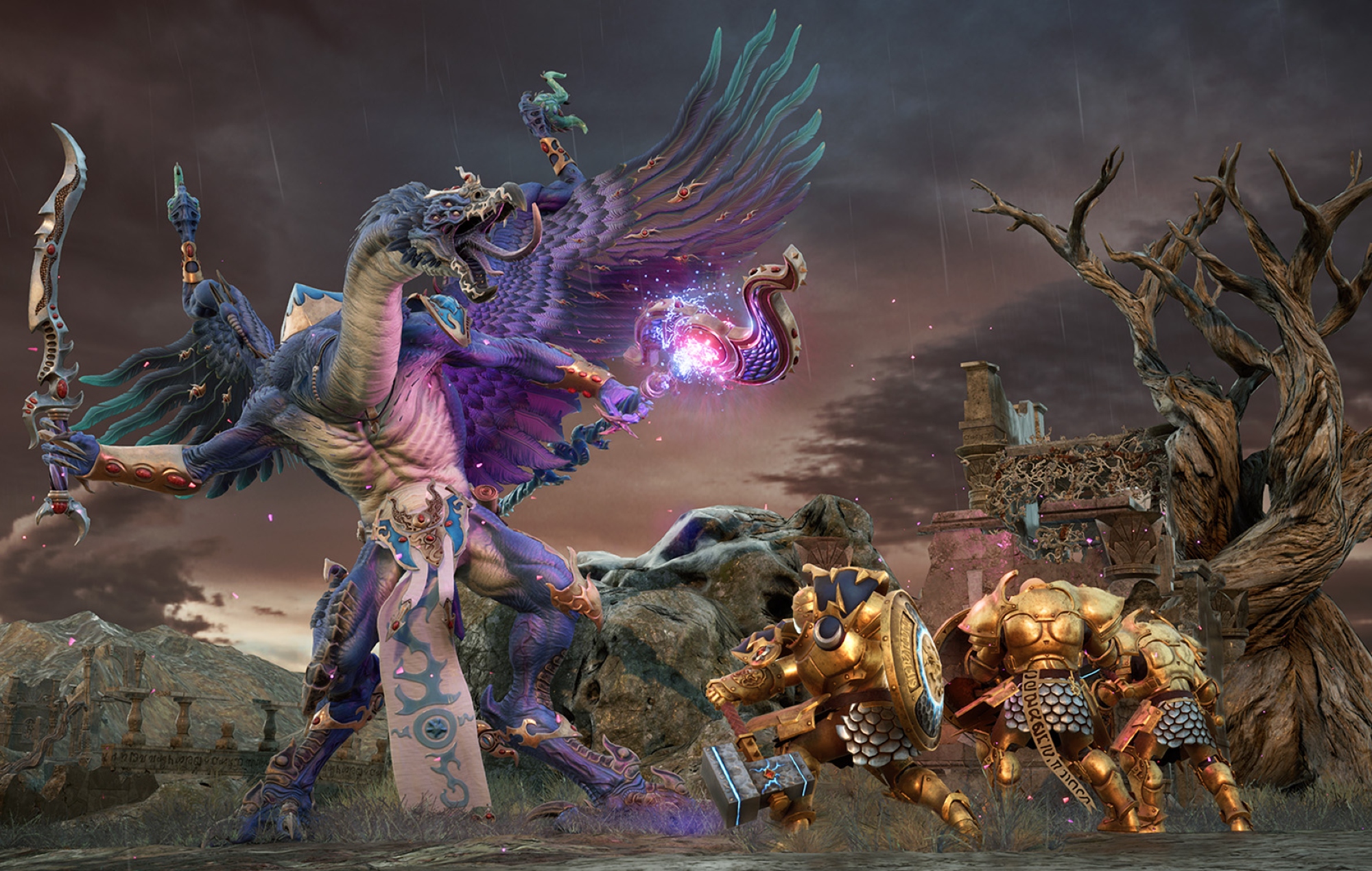Warhammer‘s Age Of Sigmar universe can be tough to get into. It’s easy to look at the stoic, shining Stormcast Eternals, figure they must be entirely devoid of personality, and then extrapolate that to the entire high fantasy setting. Yet veteran Games Workshop writer Gav Thorpe’s penmanship, clever mission design, and gripping cinematics make real-time strategy (RTS) Warhammer Age Of Sigmar: Realms Of Ruin’s 12-hour campaign as entertaining an entry as you could want – and if it doesn’t help shift a few plastic Troggoths or pots of Nuln Oil, we’ll drink our paint water.
READ MORE: There’s never been a better time to be a ‘Warhammer’ fan
Generous or not, though, the campaign will only see you so far. What’s really going to justify the price tag here is whether you’re up for learning the finer points of the competitive game. ROR slots nicely into Relic’s design lineage, so Dawn of War fans will be right at home. From a single central building, you’ll send forth small groups of units to capture victory and strategic points, accrue resources, upgrade units, and build out those strategic points into map-defining landmarks, all while trying to outfight, outsmart, and outmaneuver your opponent. More victory points mean a quicker reduction of your opponent’s score, and when either side hits zero, the other wins.
Warhammer Age Of Sigmar: Realms Of Ruin. Credit: Frontier Developments.
It all makes for an intricate tug of war. Defensively turtling is discouraged in favor of constant aggression. Every divergence from absolute stalemate is a minor victory, and even the smallest win can ripple through future skirmishes. Resources fall into three categories; Command, Realmstone, and Population. As is the mark of any good RTS, you’ll likely never have quite enough of any of them to do exactly what you want. Split-second prioritisation and short-term plans constantly jostle for brain space with micro-managing both unit position and hero abilities.
Cleverly, those hero abilities – as well as being on the usual cooldown – also eat up the very same resources you’ll want to hoard to develop your structures. It’s these tradeoffs that really elevate ROR. It can be tempting to just smash and grab the strategic points, but the longer you’re willing to park units there, the bigger your zone of control grows. This means more resources, and a harder time for anyone trying to capture it. The victory points themselves, however, can be taken or lost in moments.
Warhammer Age Of Sigmar: Realms Of Ruin. Credit: Frontier Developments.
It’s a solid ruleset, and top-tier production values in bringing Age Of Sigmar to life. Each of the four factions – Stormcast, Orruks, Nighthaunt, and Tzeentch – boast a unit roster running from basic to showstoppers, with dragons and ogres soon joining the rank and file. Each is animated beautifully, and the sound design is no slouch either – especially the campaign’s sweeping score.
What sets ROR back somewhat is a few quality-of-life control issues – more egregious in a genre where knowing your keyboard shortcuts is a significant advantage. Grouping units follows the standard RTS control scheme, but the menu offered no solution to ungroup. There’s also a noticeable amount of stickiness once units get engaged in a melee. These are minor issues, all told, but with action this fast and fluid, they stand out.
Warhammer Age Of Sigmar: Realms Of Ruin. Credit: Frontier Developments.
Perhaps ROR’s biggest wasted opportunity is its Conquest mode. All in all, the campaign, multiplayer, skirmish, army painter, and conquest modes present a generous package – but only if you’re likely to engage with all of them. This is – and we suppose this is the seller– the first genuinely exciting Age Of Sigmar game. It stands to reason a fair few fans will just want a stress-free way to engage with this universe.
If so, they’re likely to find what’s on offer a bit lacking: a map-based gauntlet of skirmish battles with the bare minimum of contiguous effects to string them together, plus a few admittedly interesting modifiers. It’s serviceable, just lacking the effort that’s gone into the campaign. Fostering a competitive multiplayer scene is a huge focus of the genre, but Warhammer‘s first two Dawn Of War games have remained so revered precisely because of the depth of their single-player offerings. It’s a depth ROR can’t quite muster.
We’re so far removed from the era where you were lucky to get a decent Warhammer digital game that the cliche has lost all relevance, but even as quality improves across the board, Realms Of Ruin deserves to sit alongside the best digital adaptions of a Games Workshop property. If you plan to get stuck into the whole package, this is a very easy recommendation. If not, Realms Of Ruin still offers an incredibly solid campaign, but holding out for Conquest mode to get a few more bells and whistles is probably the right call. Either way, it’s nice to have yet another fantasy universe to care about, and possibly spend entire utility bills on plastic dragons for.
Warhammer Age Of Sigmar: Realms Of Ruin launches on November 17 for PC, PS5, and Xbox Series X|S. We played on PC.
Verdict
Great production values, lively and thoughtful RTS battles, and a clear love for the setting make Realms Of Ruin the first truly exciting Age Of Sigmar game. However, fans looking for a pure single-player experience might find its excellent campaign a little too light to justify the price of entry, while Conquest mode is a lacklustre consolation prize.
Pros
Brilliant and lengthy story campaign that’s enough to sell anyone on the setting
Four factions bring a lot of variety; strategic, visual, and thematic
Clever twists to the competitive RTS formula keep up the tension even into the late-game
Cons
Conquest mode is an underbaked consolation prize for single player
A few QOL control issues
No Seraphon, obviously
The post ‘Warhammer Age Of Sigmar: Realms Of Ruin’ review: the setting’s first must-play game appeared first on NME.




